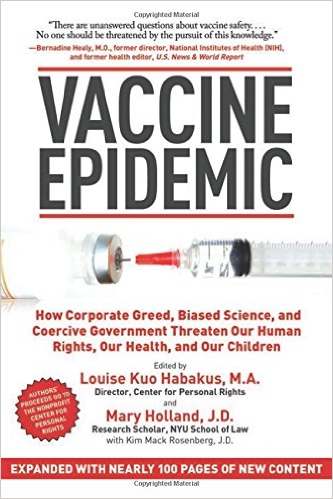I’ve been dismayed by the national measles brouhaha characterized by the Four “Astroturf” Horsemen of Vaccine Hysteria: Fear, Anger, Blame, Hatred.
- The unvaccinated must be hunted down and punished
- Measles is deadly
- We need a federal mandate for (measles) vaccination
- No exemptions for anyone
There’s nary a mainstream outlet that hasn’t jumped in and piled on. For a group of investigative journalists, health reporters, seasoned writers, and popular bloggers that claims to wrap themselves in the cloak of modern science, there’s precious little scientific or even analytic thinking, let alone responsible, measured discussion. It remains to be seen whether mainstream journalism will grow a spine.
In the meantime, however, what concerns me is how little parents know about the combination measles, mumps & rubella vaccine (MMR).
I worry about informed consent.
In this post (Part One), we address the safety of the vaccine itself. In Part Two, we’ll investigate what’s going on with its manufacturer, Merck & Co.
Documentation of adverse events
Let’s start with the basics:
- MMR package insert
- MMRV / ProQuad package insert
- Observed Rate of Vaccine Reactions – Measles, Mumps & Rubella Vaccines from the World Health Organization
- Vaccine Adverse Events Reporting System
- Vaccine Injury Table of the federal Vaccine Injury Compensation Program
- The Pink Book: Course Textbook, chapter 12 (Measles) from the CDC
- Can Measles Vaccine Cause Injury & Death? from the National Vaccine Information Center
Measles can travel via neurons to your brain
Measles virus can present as three different forms of infection in the central nervous system.
We’ve known that measles virus can travel via neuronal spread and enter the brain. It’s called “axonal transport” and it’s as fast as it sounds.
What is not commonly understood, however, is that it’s not just the natural contraction of disease that’s implicated. Vaccination can carry measles virus to your brain, too. From a study in the peer-reviewed Current Topics in Microbiology and Immunology:
[A]ttenuated vaccine strain can traffic to the brain under conditions of poor immune surveillance.
Injection of MMR vaccine can cause the live measles virus to hop a neurological bullet train to your brain.
The Merck Manual acknowledges that vaccines can cause brain damage:
Encephalitis is inflammation of the brain that occurs when a virus directly infects the brain or when a virus, vaccine, or something else triggers inflammation. The spinal cord may also be involved, resulting in a disorder called encephalomyelitis.
The problem is that we don’t know as much as we should, given the way we vaccinate children today. This 2012 peer-reviewed summary in the journal Progress on Health Sciences makes a similar point about the neurologic adverse events following vaccination:
In this study, the measles viruses were researched, but under the immunization program children also receive vaccinations with simultaneous administration of several viral components. What then occurs in the brain of a child? Presently, there are no studies in this area.
Old science, you say?
When it comes to informed consent on the MMR vaccine, the package insert is a good place to start.
A colleague of mine calculated the average publication date of every piece of science in the package insert and came up with… 1982. We’re talking roughly 33 years ago — with some studies much older than that. Does it make you wonder…
How much of today’s vaccine policy is based on yesterday’s science?
Who’s responsible for updating it? Making a case for R&D?
If large numbers of parents are doing this research on their own and calling for more vaccine safety studies, doesn’t this make them pro-science?
Who, then, are the anti-science denialists?
How about science from one month ago?
This new study, “Safety of Measles-Containing Vaccines in 1-Year-Old Children,” was quietly published online on January 5, 2015 by Pediatrics, the journal of the American Academy of Pediatrics. Here’s the abstract and the full study.
The article compares the administration of MMRV (“ProQuad”) versus MMR + Varicella (“Varivax”) separately. The authors confirm that there are more febrile seizures in children who get MMRV as a single shot than those who get MMR + V separately but on the same day.
This is significant.
The separation of the shots is not the only variable. In fact, the separation of the shots may not be much of a variable at all since both groups are getting all four vaccine infections simultaneously. It shouldn’t matter where on the body you inject the vaccine viruses since all four vaccine virus strains produce systemic, whole body infections, right?
So why is there a difference in health outcomes (i.e., seizures and possibly other sequelae)?
The vaccines are not the same.
MMRV contains nearly 10 times more varicella potency than MMR + V (this is available in the package inserts). The MMRV group is getting a much higher dose. It’s the total dose of the vaccine that causes the problem. If MMR + V is safer than MMRV, then that argues that M + M + R is safer than MMR.
Keep reading to find out why combination vaccines require greater viral potency.
Mumps vaccine isn’t effective
From 1967-1977, mumps incidence in young children plummeted following introduction of the mumps vaccine. It was nearly eliminated by 2001. Starting in 2006, however, large mumps outbreaks began occurring in vaccinated young adult populations. Possible reasons include waning immunity; a mismatch between vaccine and outbreak strains; viral competition among the M, M, R, and V components of the combination MMR II and ProQuad vaccines.
Merck has been monkeying around with the mumps component of MMR while keeping the measles and rubella components stable. The antigenic material, calculated as Tissue Culture Infective Dose (TCID50) units of infectious virus titer, was quadrupled to 20,000 in 1990 and then halved to 12,500 in 2007 (see then vs now). None of these changes were significant enough to invite FDA scrutiny of their lucrative vaccine monopoly.
Merck may have known the vaccine wasn’t up to snuff. In 2012, two lawsuits were filed alleging that Merck has engaged in a campaign since the 1990s to hide the declining efficacy of the mumps vaccine. Two former Merck virologists say they witnessed improper testing and data falsification.
Measles vaccine is cultured on human tissue
The two versions of the vaccine available in the U.S. are MMR-II and MMRV. Both contain WI-38 human diploid lung fibroblasts. This is significant for several reasons:
First, these cells are cultured on fetal tissue derived from terminated pregnancies (abortions). For some parents, abortion violates their religious beliefs or principles. Parents who oppose abortion and do not want these and other vaccines cultured on human diploid cells should have the right to decline these vaccines for themselves and their children.
Second, injection of human biologics always carries with it the risk of both known and unexpected (“adventitious”) agents, including the possibility of viral contamination (i.e., SV40 in the polio vaccine), ERV infection (endogenous retroviruses), and DNA insertion into the host genome.
Buy one, get two “free” – the history
If measles vaccine is so important, why isn’t the monovalent measles vaccine available? A monovalent vaccine contains antigens from a single strain of a microorganism. Why do our children have to get vaccine targeted against three different diseases at the same time?
MERCK STOPPED MAKING IT…
On Christmas Eve 2008, Merck quietly announced on the American Academy of Family Physicians site that it would no longer make separate “monovalent” measles, mumps, and rubella vaccines and would instead be focusing on their combination MMR. shot. This article, which is no longer available on the AAFP, Merck, or any other “establishment” site, read as follows:
Merck & Co. Inc. has stopped production and sales of its monovalent vaccines for measles, mumps and rubella. The manufacturer instead plans to focus on its combination vaccine, MMRII.
Merck spokeswoman Amy Rose said MMRII accounts for 98% of the company’s volume for measles, mumps and rubella vaccines…
“The combination vaccine is what’s recommended, and it’s such a significant portion of the orders we see,” said Rose. “It’s in the best interest of public health to make more of that rather than dedicate manufacturing capacity to monovalents.”
Rose said Merck had not decided when, or if, it might make the monovalent vaccines available for sale in the future.
… THEN THEY FLIP-FLOPPED
Merck received a deluge of complaints from concerned parents. The company responded that it would make them again. This commitment was also documented in this Merck Vaccines Supply Status from 7.20.09 (read the footnote).
This intention was not long-lived. Perhaps Merck had just been testing the waters and determined there would be no lasting brand damage? The pharma giant quietly reneged in October 2009 with this statement:
Based on input from the Advisory Committee on Immunization Practices (ACIP), professional societies, scientific leaders, and customers, Merck has decided not to resume production of ATTENUVAX® … MUMPSVAX® … and MERUVAX® II. This science-based decision will support vaccination of the largest group of appropriate individuals. Merck will continue to focus necessary resources to ensure that they can help meet current and future global public health needs… [emphasis mine]
It is interesting that they chose to describe their decision as “science-based” and their focus expands far beyond our country’s borders.
Merck hasn’t spoken on the matter since. I never saw any public discussion about the merits of this decision. Nearly all press related to this significant public health announcement has been removed from the internet.
“NO HARM IN GETTING ALL THREE”
The AAFP tried a bit of clumsy damage control:
Doug Campos-Outcalt, MD, MPA., who serves as the AAFP’s liaison to the CDC’s Advisory Committee on Immunization Practices… said Merck’s decision was insignificant in terms of public health… [but] some parents likely will be unhappy.
“The use of the single antigen is pretty limited,” he said. “There’s no harm if you need one in getting all three. There are some parents out there that want a delayed vaccine schedule. They want the vaccines spread out over a longer period of time and not so many at once. That’s a lot of hooey. Alternative schedules have never been proven to be superior.”
I’d like to see the scientific support for Campos-Outcalt’s statement. Combination vaccines are associated with the lion’s share of vaccine injury compensation claims. Scientists acknowledge that combination vaccines have greater “reactogenicity” [Katkocin & Hsieh, p. 57]. Reactogencity is the property of a vaccine to produce common, expected adverse reactions (i.e., injury and death).
PARENTS SPEAK UP
Parents wanted the individual vaccines very badly. Some were in the process of separating the vaccines. I was contacted by dozens who were frantically calling pharmacies and children’s hospitals across the country trying to locate the last few remaining doses. I know of parents who traveled overseas with their children to obtain the individual measles vaccine.
Although the monovalents are unlicensed in Britain, private clinics that offer the single vaccines do a brisk business, and parents are willing to pay out of pocket. The “Single measles jab” article in the Daily Mail says it’s not illegal to import the vaccines and names private practice doctors who can help.
Demand and supply
I am not arguing for measles vaccination with the monovalent vaccine. This serious, private medical decision is for parents to make.
But let’s examine the logic for a moment. There are some parents who choose not to vaccinate their children with MMR or MMRV who might opt to vaccinate their children against measles if the monovalent measles vaccine were available:
- Maybe they agree with the World Health Organization that rubella is typically a mild, self-limited illness (and chickenpox, too).
- Maybe they don’t want the human fetal DNA fragments in the rubella vaccine.
- Maybe their child already has positive titers for mumps and/or rubella.
If the stated public health goal is to prevent measles outbreaks, and vaccination is the proposed solution, why not offer the measles vaccine in all forms that parents are willing to accept?
I offer three possible reasons:
#1: PROFITABILITY
Combination vaccines are more profitable.
Exclusive reliance on combination shots results in more vaccines purchased and administered. Let’s use New Jersey’s “Minimum Immunization Requirements for School Attendance” to illustrate the point. Children born after 1/1/90 need 1 dose of mumps vaccine, 1 dose of rubella vaccine, and 2 doses of measles vaccine. Since it’s not possible to get the measles vaccine separately, children must receive 2 doses of each to meet NJ’s mandate for day care and school admission.
#2: INCONVENIENT QUESTIONS
Availability of both individual vaccines and the combination vaccine might prompt parents and clinicians to scrutinize differences and ask Merck some difficult questions:
Q: Why is there so much more scientific literature on the safety of the individual measles vaccine and very little on the combination MMR vaccine?
Q: Are you concerned about immunological interference between components of a combination vaccine?
I found this statement by a Merck scientist about the challenges of making MMRV:
“Numerous studies have shown that when a monovalent dose of varicella vaccine is added to an MMR vaccine the titer of antibody against varicella is reduced by about one-half. This is believed to be due to immunological interference by the measles vaccine.”
Q: Can you explain this statement in the Merck’s package insert for MMR about multiple simultaneous vaccination?
“Routine administration of DTP (diphtheria, tetanus, pertussis) and/or OPV (oral poliovirus vaccine) concurrently with measles, mumps and rubella vaccines is not recommended because there are limited data relating to the simultaneous administration of these antigens.” [page 9]
#3: WHO’S IN CONTROL?
The availability of individual vaccines gives parents and clinicians greater flexibility and control over vaccine selection and timing. If sufficiently large numbers of children are vaccinated using different vaccines and schedules, it could give rise to disconcerting variations in health outcomes. Requiring all children to receive the combination vaccine takes this potential scenario off the table.
***
Hundreds of millions of children have received Merck vaccines. The combination MMR is its flagship vaccine: profitable and prevalent, with exceptionally consistent and high compliance. Public confidence in vaccines is based upon trust. Parents should know that Merck has every interest in serving up a very simple narrative about vaccine safety and individual choice. It doesn’t mean that all parents will choose not to vaccinate. It does mean that they have to work hard to get the information they deserve.
Next up: Part 2 in our series on (Un)Informed Consent and the Measles, Mumps & Rubella Vaccine. What’s Going On with Merck?
Like and follow us on Facebook and Twitter. Sign up here.
© 2015 Fearless Parent
 Louise is grateful to be part of a community of fearless parents who are getting it done and reaching out to others. Join us!
Louise is grateful to be part of a community of fearless parents who are getting it done and reaching out to others. Join us!













This was a good read . I’m a mom of a vaccine injured child and I believed my health care system when they said vaccines were safe. I am way more educated now, because of his injury from MMR. What is in this article is not new to me, as it is for so many, but it was easy to read and I think for people who may not know what to think about MMR it is a good read. If I had been given this information before hand I would not have vaccinated him with the MMR, and I certainly would not have had him vaccinated while teething or given him Tylenol afterwards, but that’s a whole other important story. I was never given a chance for informed consent. Informed consent simply doesn’t exist in the medical industry . It’s up to parents to inform themselves before getting pregnant. I say before because at 8 weeks into my pregnancy they also told me the flu shot was safe yet no one study exists for pregnancy and the flu shot.
Great! I added your article reference to my resource page.
http://autismrawdata.net/1/post/2013/08/raw-data-measles.html
Thank you, Heather! Look for Part 2. That link will be live tomorrow morning 2/17/15.
I thank you for such a thoughtful article and fully support what you are doing here.
Here is what I comment with on news sites and youtube. I’m so disgusted with the pushers when the science is NOT settled!
“If the people conducting peer-reviewed research can’t give complete transparency without ongoing fraud, then why would I trust them with injecting my children? If parents are forced to vaccinate under pressure of “informed consent” and still refuse because parents’ question these links posted here, that will be considered Medical Tyranny and ends medical ethics. If the mainstream avoids the information posted here it will erode further confidence the people have of the state. Until I can find an ethical unbiased with no criminality and fraud involved, research with reputable people from Doctors that question the mainstream research such as Dr. Hooker whom CDC’s Dr. Thompson is very familiar with.
Dr. Thompson has a lawyer regarding his own fraudulent research at the CDC. He admits it here in a statement from his lawyers website.
http://www.morganverkamp.com/august-27-2014-press-release-statement-of-william-w-thompson-ph-d-regarding-the-2004-article-examining-the-possibility-of-a-relationship-between-mmr-vaccine-and-autism/
Mainstream media mocking hit piece on Dr. Hooker. http://abcnews.go.com/Health/now-retracted-autism-study-viral/story?id=25248179
Merck’s former employees (Virologists) sue Merck for data fraud. Now I have more questions about the scientific research. The filings are very damning for Merck. This lawsuit is about the 95% efficacy Merck reported to FDA as required by regulations. The Merck whistle-blowers research showed less than 95% efficacy and reported it to FDA. Merck’s upper management denies the claim. Judge ruled against Merck to dismiss and it moves forward in court. http://www.kellergroverwhistleblowerlawyers.com/active-cases.html
And when we have Poul Thorson who was indicted for stealing grant monies from CDC’s Autism research fund. http://www.justice.gov/usao/gan/press/2011/04-13-11.html
Merck MMR vaccine – Warnings page 4; PRECAUTIONS page 5; ADVERSE REACTIONS page 7; – http://www.merck.com/product/usa/pi_circulars/m/mmr_ii/mmr_ii_pi.pdf
Federal, Vaccine Injury Compensation Reports http://www.treasurydirect.gov/govt/reports/tfmp/vaccomp/vaccomp.htm
For parents who have vaccine injured children click on link learn how to file a claim. – http://www.hrsa.gov/vaccinecompensation/fileclaim.html
To understand what the compensation is about go to Vaccine Adverse Event Reporting System (VAERS) for spreadsheet – https://vaers.hhs.gov/data/data
http://healthimpactnews.com/2015/u-s-media-blackout-italian-courts-rule-vaccines-cause-autism/
Controversial vaccine studies: Why is Bill & Melinda Gates Foundation under fire from critics in India? http://articles.economictimes.indiatimes.com/2014-08-31/news/53413161_1_hpv-vaccine-cervarix-human-papilloma-virus
Inside the Vaccine War: Measles Outbreak Rekindles Public Health Debate (2/3) – https://www.youtube.com/watch?v=P6EI59zNZ8Y
New studies show – http://www.scribd.com/doc/220807175/86-Research-Papers-Supporting-the-Vaccine-Autism-Link
Alan Phillips, J.D. Attorney for Vaccine Rights – http://www.vaccinerights.com/
http://www.slate.com/articles/health_and_science/science/2015/02/fda_inspections_fraud_fabrication_and_scientific_misconduct_are_hidden_from.html
So, it begs to question all the peer-reviewed research when so much fraud within has been established!”
I don’t understand why now everyone is concerned about the measles. When I was growing up and one child in the family got measles or chicken pox, the parents wanted all there children to have it at the same time. when a child had these childhood diseases he wouldn’t have them again because he was immune. Why are people getting these vaccines when they have had these diseases. A niece of mine got the measles after she received the shot. People need to ask their grandparents about the measles. Most of the older generation has had them and will not get them again.
In Japan, vaccination is completely optional. Japan also has a collective IQ ten points higher than the US. In fact, countries that had an optional vaccine policy vs. those countries that had mandatory vaccination policies, all had higher average IQs. I don’t need anymore information beyond that to know that vaccinations are a fraud.
Japan only give 11 vaccines compared to US 34. Japan has banned the HPV vaccine because of the damage to girls. Too bad the US does not care about the health of our children.
Pre-Vaccine mentality reflected in TV https://www.youtube.com/watch?v=mDb0ZS3vB9g
I have a question regarding Autism and the vaccine connection. Are there any documented cases of children who are autistic that had no vaccines ever administered to them??
Debbie,
I don’t know about documented cases, but I saw a mom post on the FB page “Our Kids Our Choice” (a coalition currently fighting CA’s SB277 that would eliminate exemptions) that she has an autistic child that has never been vaxed. BUT she received the DTap when she was pregnant. And I can tell you from my own research that in at least 23 cases at the VICP, the court awarded damages for children who displayed “autistic-like” behavior resulting from either the DTP or DTap vaccine specifically. They won’t say “autism” but rather “autistic-like.” Verbal gymnastics.
>>>>They won’t say “autism” but rather “autistic-like.” Verbal gymnastics.<<<<<
These verbal gymnastics are even more insane when you consider the nature of the current terminology. We went from a number of distinct disorders each having it's own separate name to "Autism Spectrum Disorder" for the purposes of lumping the many different manifestations of similar neurological disorders together.
The word "spectrum" in this context means that symptoms will appear "like" or similar to many other conditions of this nature. So to say that something is "autism-like" is a total farce perpetrated for the sole purpose of not alarming people; as well as trying to probably dodge more serious legal ramifications.
If the vaccines makers were not indemnified by the US Govt against product liability, any scientifically proven connection between vaccines and ASD would result in the largest class action suit in the history of US civil courts. It would most likely dwarf the amount money awarded when the Tobacco industry was finally held responsible for it's product liability in US civil court.
My prediction is that at some point this shell game will end. The vaccine makers will get exposed and sued for their product liability and the Govt might not cover those legal obligations any more. That process might take awhile though.
I won’t hold my breath waiting for the government to make any changes for the better, keeping in mind that the government and its agencies, the pharmaceutical industry including vaccine manufacturers, and the mainstream media are all deeply involved in this organised crime, medical fraud and crime against humanity dressed up as disease prevention by means of junk science.
Your tone and approach to this controversial topic is spot on. It’s readable, its not too preachy, it’s approachable. You treat the reader as if she/he is reasonable, smart and looking to embrace all of the data possible.
Keep up your awesome work.
I hope there are enough well informed/educated folks out there fighting this battle of opposing mandated vaccinations, I wish I could help but I don’t know how too..
If you look at statements from all the major medical organizations around the country, none of them endorse any form of mandated or legally required vaccinations.
http://www.sott.net/article/291522-Big-groups-oppose-mandatory-flu-shots-including-American-Medical-Association
You don’t say anything about the MMR and aborted fetal cells. I recently read this study. EPA Study confirms change point in autism disorder rate; correlates with aborted fetal DNA introduced in vaccines. http://www.youtube.com/cogforlife.org/2011/04/21/epa-study-correlates-to-aborted-fetal-dnaautism-link/
You are so right, Kathy. The post got so long that I needed to end it… but these are both excellent points. I will try to add a note to the bottom with some additional information as soon as possible.
Thank you Louise for this article — comprehensive, easy to read and easy to share with those new to this issue and with those who have been involved for a while.
I can relate to Sarah’s comment. I grew up in a family of five kids all born between 1947 and 1957. We all got measles, mumps. chickenpox and I think german measles too. What do I remember about measles . . . my mom pulling down the window blinds because our eyes were sensitive . . . that’s it!
I began my own vaccine research back in 1988 as I was preparing for the birth of my third child and “recommended” vaccines were on the rise. I didn’t understand why my baby would “require” more vaccines than her two older sisters who were born in 1978 and 1980. I remember asking my own mom and mothers of friends what it was like when us kids got measles, etc. They all told me the same thing — measles and all those other “routine” childhood illnesses might have been inconvenient, but they were “no big deal.” Just recently, I asked my 87 year old aunt what it was like when her four children got measles. She laughed and said, “Measles, we just waited for that to run through the house!”
Regarding individual vaccines vs. combination vaccines. I still remember my “old school” pediatrician telling me in 1979 when it was time for my oldest child’s measles vaccine that he would not give the combined shot as most other area pediatricians were giving at that time. He did not feel it was safe and said, “A child would not get those three illnesses at one time and I won’t give the three vaccines at one time.” Thank you Dr. B for your wisdom!
Let’s all continue to advocate and pray for the protection of vaccine choice rights for those who choose not to vaccinate and for safer vaccines for those who choose to vaccinate. God bless and take care . . .
Polish translation here at Prawda O Szczepionkach: http://prawdaoszczepionkach.pl/(nie)swiadoma-zgoda–czesc-1–kilka-faktow–ktorych-rodzice-nie-wiedza-o-szczepionce-mmr-(odra–swinka–rozyczka),43,145.htm
Thank you so much for the excellent article Louise!
“Public confidence in vaccines is based upon trust.”
This sentence should in my opinion read:
“Public confidence in vaccines is based upon trust in lies.”
As far as I am concerned, vaccination is a complete fraud and to keep one’s child vaccine-free the only sane option.
“Vaccines contain substances which are so noxious that they should not ever be injected into a human body.”
Australian vaccine researcher Dr Viera Scheibner PhD
What we now have is a vaccine-induced holocaust.
And while not the sole cause, vaccines are the leading cause of autism.
I wa on my way into the movie theater in Monmouth Mall, Eatontown, NJ. about a week or so ago and saw these two ladies behind a table with information about a (independent?) film on vaccines. I knew nothing about it prior to that and the movie was starting the same time as the one that I’d come there to see. She said don’t worry we’ll be back. But I’m not sure if the film is called “un informed consent” or when it comes back. None of that information is on any of the literature I grabbed as I ran into the theater. Can anyone help me out with more info? I believe she said the movie would show again in mid-Sept.
I’m adding my email so you can reply but please don’t add me to an email list. I have SO much unwanted email that I don’t have time to read. I’m only interested in the movie name and date for now.
Thanks for any information you can provide!
Liz
Our team leader said she’d contact you off line. If you don’t hear from her, please email me at info@fearlessparent.org!
My children, all born in the 80 s were born at home. When it came to vaccines, I felt that I had started out taking response/ability for them from the start and I would continue to do so. My children were not vaccinated for anything. They have always been totally fine.
My youngest got the mumps at age 28. She missed 2 days of work and could not eat citrus for a week. Now my second youngest, age 33 now has come down with mumps. She visited with a friend who s 6 yr old daughter received a number of vaccines 2 weeks ago including mmr. Viruses in vaccines shed. This is the way these diseases spread. From the recently vaccinated. My daughter may go for a test to confirm which strain of mumps she has. It is not a big deal!!! I just wish they would have gotten all the childhood diseases as young children but there was no one around in my community who got any of them except chickenpox. I was really happy that this at least came around. Childhood communicable diseases are extremely seldom a problem.
And I remember Minimata disease in Japan after a community became poisoned with fish poisoned with mercury. The children exposed to the polluted fish diet either in utero or as small children developed symptoms that today would be on the autism spectrum disorder. Somehow this has all been forgotten. It was only 45 years ago or so. Medical establishment has a selectively short memory it seems. And big pharma continues to rake in the profits from the implementation of AGENDA 21. I would suggest it may be worthwhile to inform ourselves as to what agreements our government (federal) has agreed to as regards population reduction. I will stop now